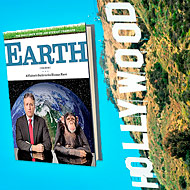This week, Jon Stewart and The Daily Show continue to expand their comedy dominion with a new book, Earth (The Book): A Visitor’s Guide to the Human Race, on sale today. As New York’s Chris Smith explained in his profile of Jon Stewart, “The conceit this time is that before disappearing from the planet — owing to ecological catastrophe, nuclear holocaust, or a pandemic that killed Dr. Nicole Kidman — humankind has left behind a guide to our existence for alien visitors. Or, more likely, alien conquerors.” The book includes authoritative descriptions of everything from “Human Anatomy” (illustrated by a gag-inducing Photoshopped image of a nude Larry King) to “Alcohol and Drugs” (which we’ll excerpt tomorrow). Herewith, The Daily Show’s Guide to Hollywood.
Moving pictures were an incredibly sophisticated technology that allowed man to re-create and project all the sights and sounds of real life, only with better-looking people. Film (or “movies,” to those not attending a campus Godard retrospective) combined theater’s emotional immediacy with photography’s spectacular realism and sound’s remarkable hear-itude, in a complete sensory experience. In later years, film added nudity and explosions … for the kids.
Imagine 400 strangers sitting in a dark, dank room, feet stuck to a disgusting adhesive floor, staring up at a flickering screen in a near-diabetic coma, desperately holding in their urine for hours at a stretch. We called it “the movies” and we fucking loved it. So will you. Just be considerate: if any part of you buzzes or beeps, turn it off first.
A small popcorn and drink were expensive, but remember, after the movie you could take them home and use them as cat coffins.
This sign was the only thing other than scripts that people in Hollywood read.
Ah, Hollywood. Behind its shiny facade lay a superficial veneer masking a shallow layer of eggshell-thin unreality. Few people dug much further. The famous people who lived and worked here were called stars, because they were volatile explosive gasballs surrounded by an entourage of dependent entities basking in their reflected glow. We called Hollywood the Dream Factory. Unfortunately most people who went to work there ended up working at the Cheesecake Factory. Of course that’s nothing for you to worry about, because baby, you’ve got it.
Chevy Chase was a legendary comedian/asshole. In Hollywood this was known as a “double threat.”
To learn that one’s hand was the same size as Jack Nicholson’s was to know the true meaning of happiness.
Sure, with perfect makeup and lighting, this starlet seems unbelievably beautiful. But see her on the street and you’d realize …
She’s merely drop-dead gorgeous.
Musicals allowed us to channel our inner homosexuality into a socially acceptable outlet.
Westerns were popular for decades until August 2, 1969, when moviemakers officially ran out of stories about men and horses.
Science Fiction was two hours of thrilling outer-space spectacle that took moviegoers’ minds off their own crushing virginity.
Blowing shit up was a hugely popular genre that inspired such subgenres as shooting shit up and punching shit.
In 1927, this film kicked off America’s enduring love affair with the talking picture. Unlike our love affair with blackface, which lasted until the Civil Rights Act of 1964.
Romantic comedies proved that even someone as hideous as Richard Gere could get a cheap whore like Julia Roberts to fall in love with him.
Animated movies presented children with a dazzling array of colorful characters they could force their parents to buy for them.
Sequels allowed popular film characters to evolve over time, exploring more sophisticated relationships and dynamics and completing long-arc narratives too complex to fit the strictures of a single feature-length film.
Police Academy penetratingly addresses Michel Foucault’s theories of authority and power dynamics.
Police Academy 2: Their First Assignment explores the inner conflicts of our hero’s id.
PA 3: Back in Training broadens its worldview to explore the cycles of time and aging.
PA 4: Citizens on Patrol probes the artificial nature of socially constructed roles.
PA 5: Assignment Miami Beach put the Milgram experiment on film and set it in Miami.
By PA 6: City Under Siege, even our joke about how good these movies were seemed old.
Some sequels were considered cynical attempts to profit from the creative success of previous ventures. Others just made sense.
[From the book The Daily Show with John Stewart Presents Earth (The Book) by Jon Stewart. Copyright © 2010 by Busboy Productions, Inc. Reprinted by permission of Grand Central Publishing. All rights reserved.]

























![Some sequels were considered cynical attempts to profit from the creative success of previous ventures. Others just made sense.
[From the book The Daily Show with John Stewart Presents Earth (The Book) by Jon Stewart. Copyright © 2010 by Busboy Productions, Inc. Reprinted by permission of Grand Central Publishing. All rights reserved.]](https://pyxis.nymag.com/v1/imgs/815/96f/75c0d01f5c2315659a5cd4ddf45c7b4ebd-19-Citizen-Kane-2.rhorizontal.w700.jpg)


